5 most innovative biosensors for rapid detection of Influenza from SensUs Student Competition 2021
Continued research on biosensors is the way to ensure humanity stays ahead of time. Presenting the biosensors developed by the top 5 highest voted teams during SensUs Student Competition 2021.
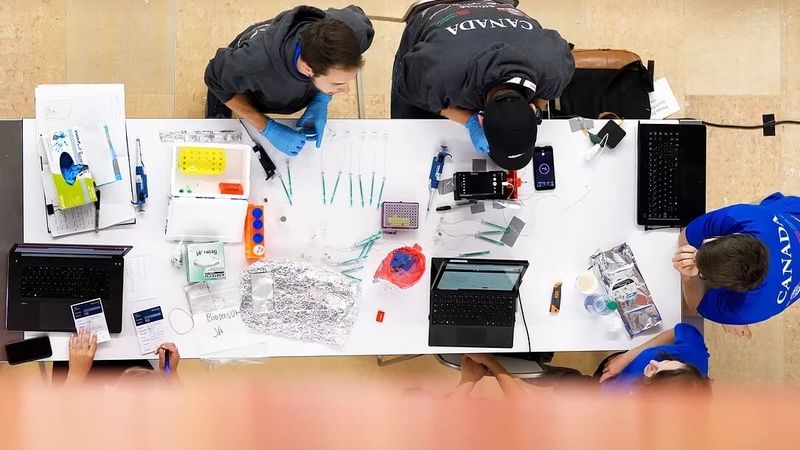
Image: SensUs / Bart van Overbeeke
Tags
SensUs is a competition that stimulates the research and development of novel biosensors. It is a yearly event where student teams from different universities develop new biosensors and share their ideas. This year, the event was organised by TU/e (Eindhoven University of Technology) on 3rd September 2021 and was streamed live on YouTube.
The event provides a platform for students to pitch their innovative biosensor prototypes and contribute to the development of medical and healthcare systems. What started off as a competition between five teams from five different countries in 2016 was this year a showcase of innovation by fourteen teams from top universities across the world.
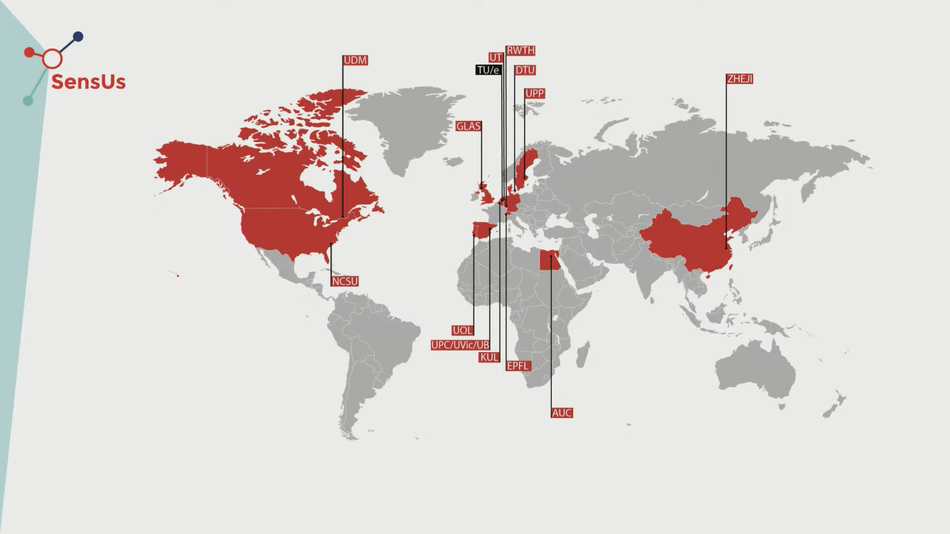
Some winning projects in the previous editions of SensUs have been patented already and are on their way to become successful biosensors in practice.
The theme of SensUs 2021
Every year, the competition is focused on the development of biosensors for detecting specific biomolecules. The previous editions of SensUs have been dedicated to developing technologies to detect a variety of different drugs, bacterias, viruses and other biomolecules.
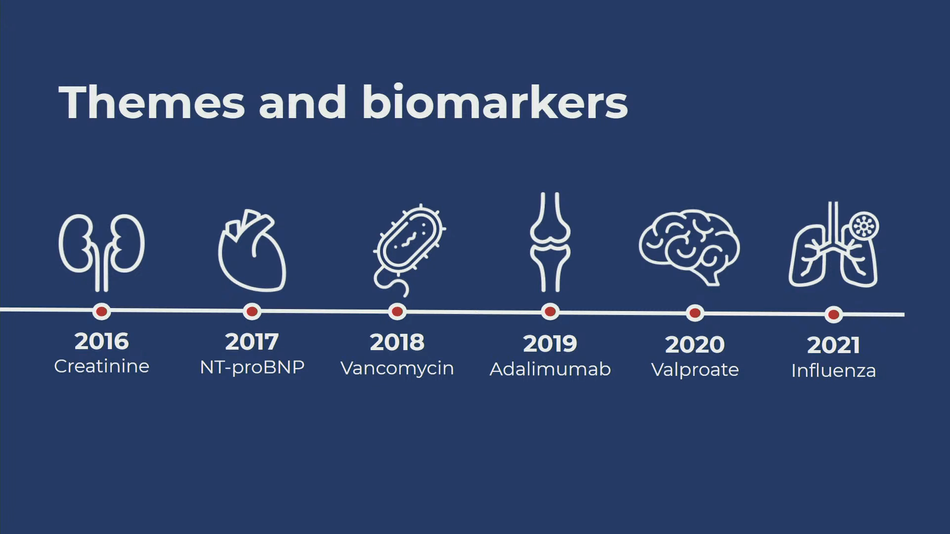
Often known as flu or the common cold, influenza is a contagious viral infection and also the theme for this year’s SensUs competition. The infection spreads by the transfer of body fluids. It affects the upper respiratory tract of the human body and is accompanied by fever, chills, runny nose, sore throat, body ache and fatigue. The symptoms go away within a week or two.
Influenza isn’t considered fatal, and in healthy individuals, medical attention is rarely required. Having said that, the infection can have severe effects on some patients with comorbidity or asthmatic allergies, especially during the winters.
At the core of the virus is the genetic material that contains the information about how to make more copies of itself. The genetic material is covered by a capsid that protects it when travelling from one place to another.
The outer protein shell of the virus contains projections of HN (hemagglutinin-neuraminidase) glycoprotein, the spikes that help the flu virus enter the target cells. There are 17 H-type and 9 N-Type spikes known to us.
The most recent instance of a flu pandemic is that of H1N1 swine flu that lasted between 2008-09. The number of estimated deaths caused by the pandemic stood at 284,000. History is the witness of the fact that influenza is more than just a seasonal infection. The outbreak of the virus can happen anytime, anywhere in the world.
As humanity passes through a tough phase of the COVID19 pandemic, the last thing we would want is the outbreak of such a pandemic anytime in future. To prevent such a situation, researchers across the world have been trying to come up with innovative biosensors for the early detection of the virus.
But before that, here is a brief introduction to biosensors.
What are biosensors?
A biosensor is an umbrella term used for devices that can analyse specific biomolecules and report an underlying disease. The biomolecules under observation are often called biomarkers. Biosensors work on a small sample of biomarkers that are taken from the human body.
Cartridge and reader instrument are the two main parts of a biosensor. The recognition molecules that respond to the presence of a particular biomarker are present on a disposable cartridge. A sample of biomolecules that needs to be tested is put on the cartridge, and then it is plugged into the main reader instrument. The instrument reads the signals from recognition molecules and converts them into meaningful measurements. Depending on the type of signal generated and transduction required, biosensors are classified into different categories such as thermal, optical, electromagnetic etc.
Using biosensors, patients and doctors can regularly keep a check on the analyte to decide the course of treatment. The technology reduces the dependency of the patients on the hospitals by allowing them to self-manage the treatment to a great extent. The most familiar biosensor today is the glucometer which is used to measure blood sugar levels.
With that out of the way, let’s now take a look at the top 5 student teams and their biosensing technologies from the competition.
Top 5 teams with most innovative biosensors from SensUs 2021
1. TruSense
TruSense is a team from Zhejiang University representing China at SensUs. TruSense’s biosensor for the detection of influenza is built on an OECT (Organic Electrochemical Transistor), a popular bioelectronics structure. The construction of the biosensor is pretty straightforward to understand.
The source and drain electrodes of the OECT are made by screen printing carbon on PET (Polyethylene Terephthalate) substrate. PEDOT: PSS (poly(3,4-ethylene dioxythiophene) polystyrene sulfonate) is used as the organic semiconductor material for forming the channel of the transistor. The gate electrode of the OECT is made of gold. The whole setup of the detection is built on a disposable cartridge that plugs into a very compact handheld instrument. Within the device is an LMP91000 programmable Analog Front End (AFE) potentiostat interfaced with an ESP32 with a customised program code.

When hemagglutinin is attached to the immobilised antibodies on the gate terminal of the OCET, its electric potential changes. Due to this change in gate potential, there is a change in the drain current of the transistor acting as an indicator of the test result.
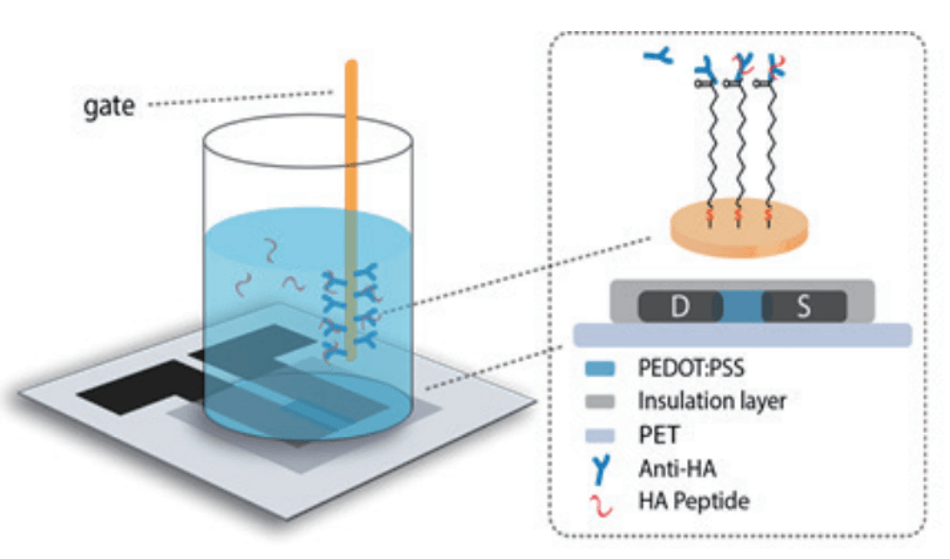
The TruSense team expects to price the testing device under €20 and the disposable cartridges for around €1, which is a very affordable and aggressive price. China, with its population of over 1.4 Billion, can open up a lot of opportunities for innovative biosensors like the one developed by TruSense. Within four years, the team aims to generate a revenue of € 8.37 Million by selling instruments, cartridges and subscriptions.
2. AUSense
AUSense is a team from The American University in Cairo representing Egypt at SensUs. The team consists of undergraduate and graduate students from biology, biotechnology, chemistry, electronics and computer science streams. Team AUSense has developed a biosensor that can quantify hemagglutinin in saliva even at low concentrations.
The prerequisite for detecting influenza A virus with AUSense’s biosensor is the treatment of the saliva sample with Cysteine Ethyl Ester and Phosphate-Buffered Saline (PBS) solution. This is done to reduce the viscosity of the liquid and make testing more accurate.
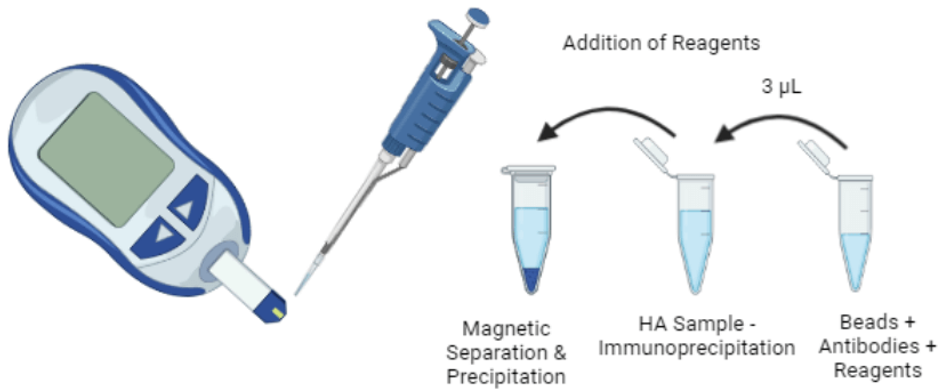
Then, immunoprecipitation is carried out using magnetic separators. Small magnetic beads of around 0.5 µm in size bind with Polyclonal antibodies attached to the hemagglutinin antigen present in the saliva sample.
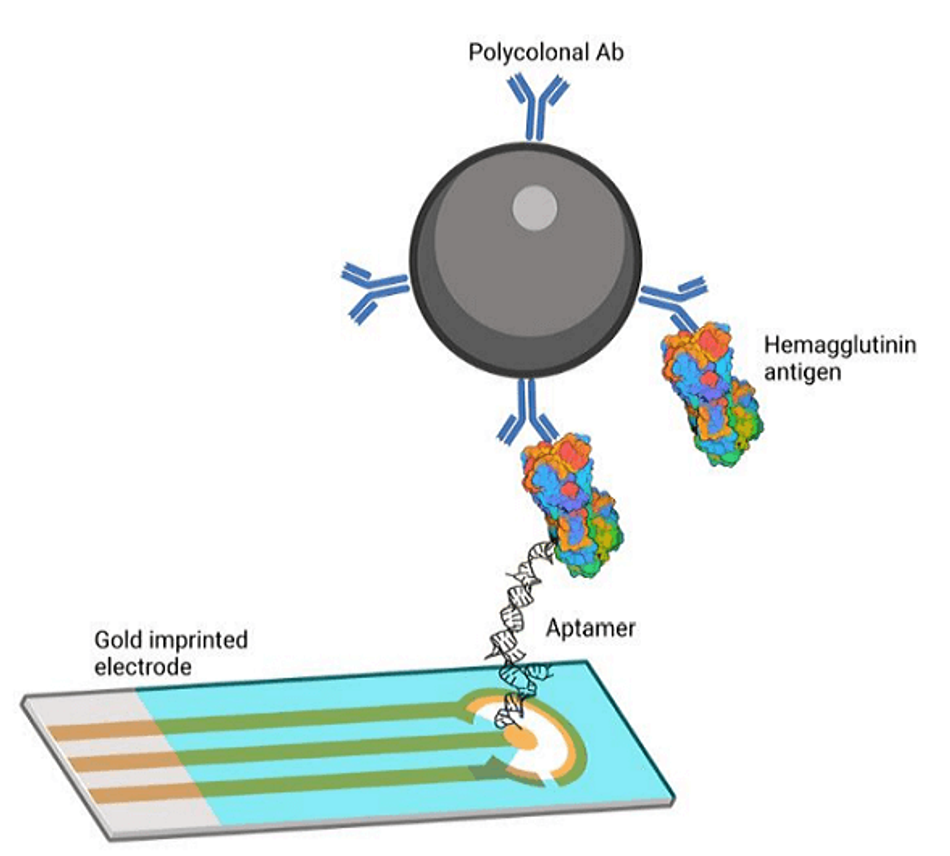
The whole complex will be loaded on a gold imprinted electrode having RNA aptamers on it. But before that, the electrode is treated by Dithiothreitol (DTT) reduction reaction. Once done, the aptamers present on the electrode get immobilised. When the test saliva sample is put on the electrode, hemagglutinin protein molecules are trapped. This causes a change in the impedance of the electrode, which can be translated into the concentration readings with the help of a potentiostat.
The mobile application that accompanies the device will fix any non-linearities in the readings and present the user with the results. Even though using the biosensor seems slightly complicated, it doesn't require trained personnel.
The team has also identified a few limitations on which they would like to work upon. One such limitation is related to using multiple reagents, which is time-consuming; and using antibodies for enrichment just adds to it.
Using a microfluidic cartridge can be an alternative to the present enrichment kit.Another good option will be using prefilled syringes containing the reagents so that the volumes of reagents need not be measured every time.
AUSense aims to target airports and hospitals in Egypt where a Point of Care (POC) system for quickly screening for influenza is a dire need. The device would cost under $ 35 and provide an alternative for PCR kits that can cost over $5,000. The team has also introduced some modifications that can enable the biosensor for COVID-19 detection.
3. PULSe
PULSe is an interdisciplinary team from KU (Katholieke Universiteit) Leuven representing Belgium at SensUs. The team consists of students of biomedical science, bioinformatics, biochemistry, biotechnology, bionanotechnology, bioscience engineering and medicine.
The working of the biosensor can be explained in three steps: Aptamer detection, MNAZyme (Multicomponent Nucleic Acid enzymes) signal generation and CRISPR/Cas13 signal application. The first reservoir of the cartridge contains aptamer inhibitor molecules and MNAZyme functionalised magnetic beads. When saliva enters the first reservoir, if any hemagglutinin molecules are present in it, it will bind with aptamers, causing them to disassociate from the inhibitor. The inhibitor will now be free to attach to the magnetic bead.

This is when the functionalised magnetic beads will be moved to the second reservoir filled with molecular beacons that can be cleaved by MNAZymes, resulting in the separation of the fluorophore from the quencher. These molecular beacons can find their complementary CRISPR RNA strand and activate Cas 13 protein. Once activated, the protein can cleave reporters also present in the reservoir again, resulting in the separation of the fluorophore and intensifying the signal.
To use the device, the user has to place their smartphone on the dock. Next up, the sample of saliva needs to be deposited on the disposable cartridge and slid into the main instrument. The cartridge is made to move through a set of electromagnets, magnetic beads functionalized by MNAZymes. When the sample mixed with beads reaches the second reservoir, the beads cleave the molecular beacons to generate a fluorescent signal, the strength of which has a positive linear correlation with the concentration of hemagglutinin.
The user’s smartphone acts as a data acquisition and communication device for the remote cloud server where the actual signal processing takes place. Once the results are ready, a notification is pushed to the user.
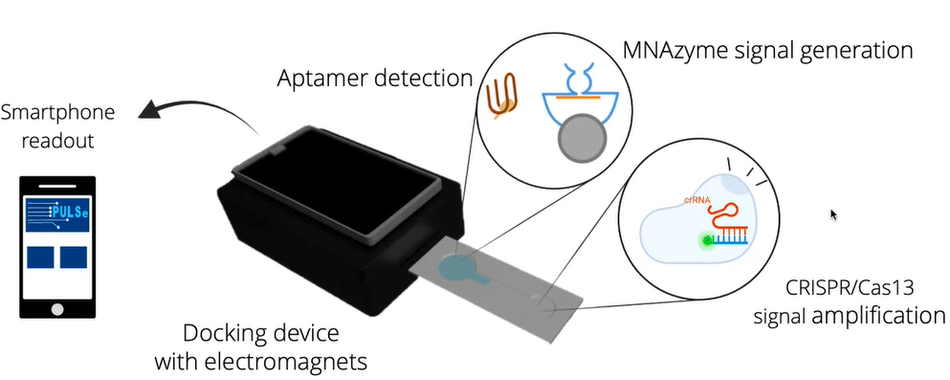
PULSe has identified three streams of revenues for the business: Docking devices, cartridges and data. The estimated cost of the docking device is €40, which will come down to €30 by 2027. The cartridges can be priced at around €10. The team aims to go commercial by 2023 and starts generating an inward cash flow by 2025-2026, five years since the beginning of development.
4. SenSwiss
Twelve young and dynamic students pursuing their masters in micro-engineering and life science engineering have built a biosensor based on the principle of EOT (Extraordinary Optical Transmission). SenSwiss is a team from École Polytechnique Fédérale de Lausanne representing Switzerland at SensUS this year.
Their biosensor uses a special form of surface plasmon resonance, an optical technique of studying molecular interactions. According to the principle of EOT, when light passes through apertures smaller than its wavelength, it gets brighter and more focused. The apertures in the case of this biosensor are the nanoholes of radius 100 nm made on a gold sheet. Due to the coupling of plasmons to the surface, a lot of light goes through the holes, adding some amount of transparency to the structure.

To functionalize the setup, capture antibodies (11055-RM05 Sinobiological) are put on a gold nanohole array (Au-NHA) surface and detection antibodies (11055-MM04T Sinobiological) are put on gold nanoparticles (Au-NP). When one end of hemagglutinin binds with the Au-NP and the other with Au-NHP, it gets trapped in the setup. The whole molecule now clogs the nearest nanoholes present in the Au-NHA, stopping any light from passing through it, thereby creating dark shadows/spots.
To have a maximum binding of target molecules with Au-NHA, instead of using just natural flow, a microfluidic cartridge and pump are used. We no longer have to depend on natural diffusion. The saliva sample is flowed back and forth to increase the time of interaction between the target molecules and Au-NHA.
Next up, to observe the shadows/spots, a setup of LED (Light Emitting Diode), lens and 660 nm wavelength filter is used. The applied light passes through the lens, wavelength filter and the Au-NHP surface right to the CMOS (Complementary Metal-Oxide Semiconductor) camera.
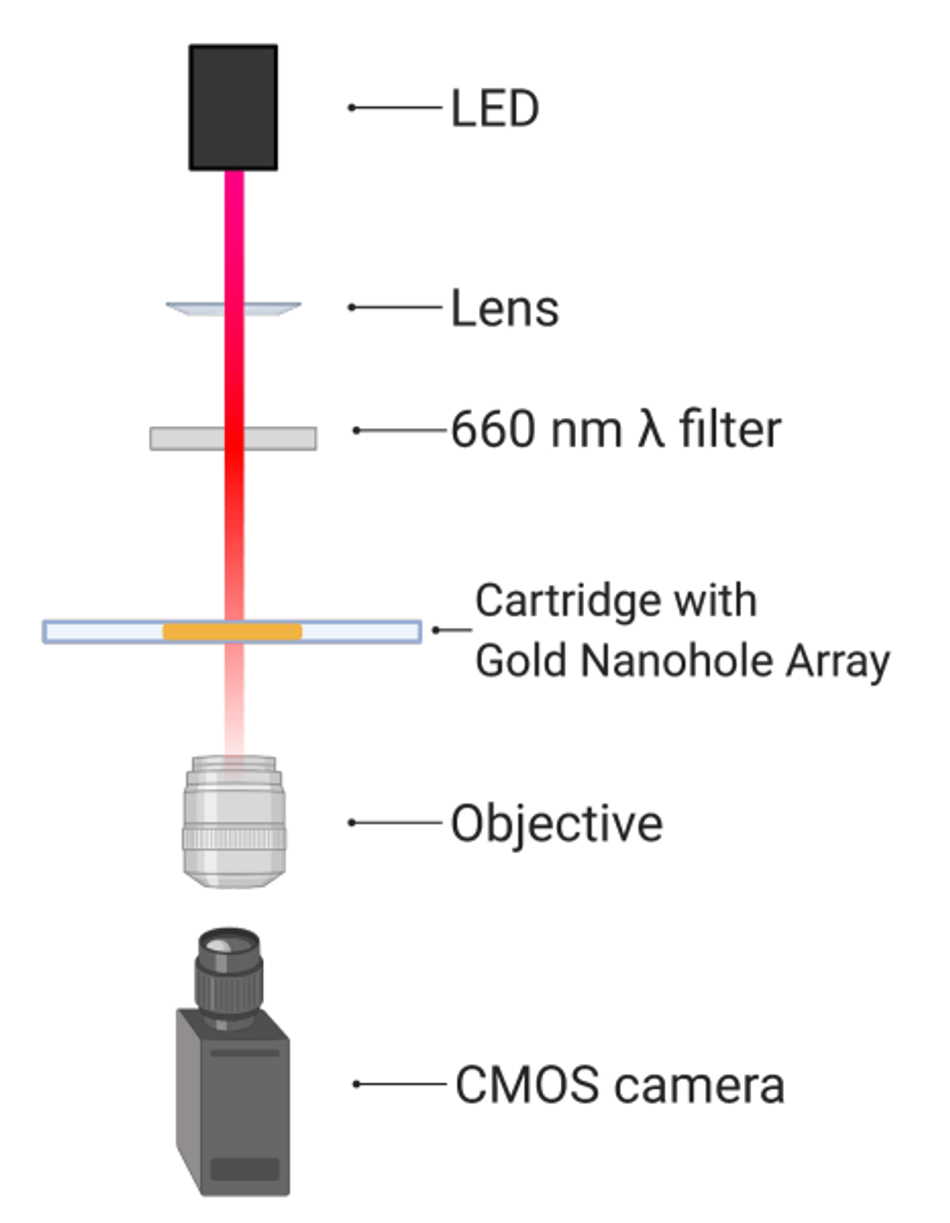
By counting the number of black spots that appear, it is possible to estimate the presence and concentration of the Influenza A virus. The device collects image samples for four minutes and instantly shows the result of the test. The process requires a lot of image processing in real-time. It is possible to detect single and individual binding events in samples even with a fairly large concentration of hemagglutinin.
But before the test is carried out, the saliva sample needs to be preprocessed by centrifuging it at 11,000 RPM for a minute. This settles down the larger mucin proteins present in the saliva; just the supernatant is used for the analysis.
The SenSwiss team aims to further automate the centrifuging, pipetting, cartridge preparation during the sample preparation process. The team also plans to integrate image acquisition and image processing systems into a single API to get all the information on one screen.
5. AixSense
Last but definitely not least is team AixSense from RWTH (Rheinisch-Westfälische Technische Hochschule) Aachen, representing Germany in the competition. AixSense has developed a biosensor based on biofunctionalised Ion Sensitive Field Effect Transistors (ISFETs) to detect the concentration of hemagglutinin in a saliva sample.
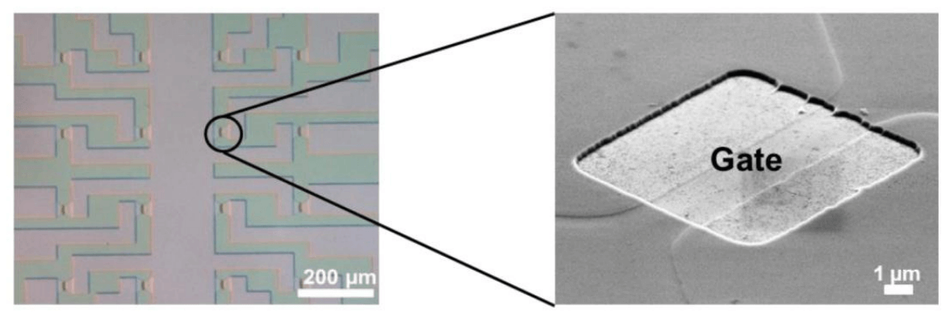
First, let’s take a look at the process of preparing the cartridge for the device. Using piranha solution, the gate terminals of ISFETs are chemically activated to enable them to form covalent bonds with functional organosilanes. Then, 3-glycidoxypropyltri-methoxy silane (GPTMS) is used for silanization.
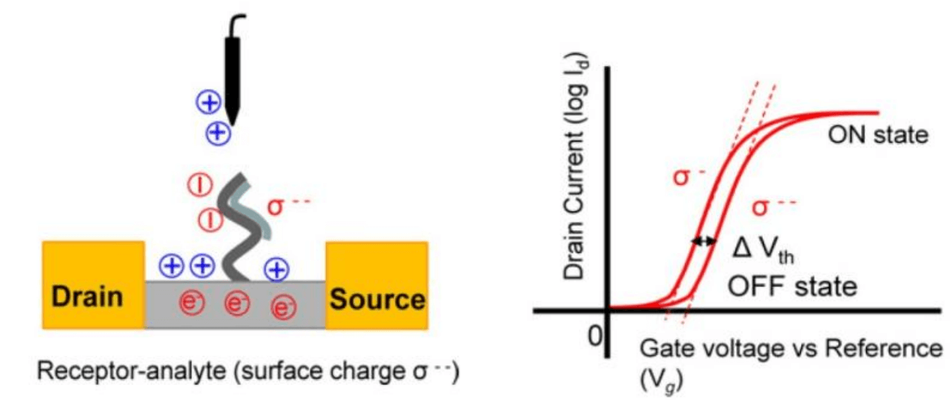
Finally, the aptamers are micro-spotted on the sensor surface. After the preparation of the bio-functional layer, a reservoir is built from polydimethylsiloxane (PDMS), again, directly on the sensor’s surface. This concludes the development of the cartridge that can be stored for months in refrigeration before use. The most impressive thing about the cartridges is that they are designed to be recyclable to have a minimum impact on the environment.
When hemagglutinin binds with the gate terminal of the ISFET, there is a change in the VI characteristics of the transistor. In other words, a change in the Drain-Source potential can be observed, which is proportional to the concentration of the protein in the sample solution; as the concentration of the hemagglutinin increases, the drain current decreases.
Team AixSense already has a functioning prototype giving fantastic results. To make it a marketable device, the prototype needs to be able to handle real-world use cases.
Final words
All the biosensors developed by the teams that participated at SensUs 2021 were full of creativity. The novel biosensor designs hold the potential to change influenza testing forever. A lot of participating teams at SensUs 2021 can be incubated into profitable startups.
To improve the quality of healthcare and diagnostics, the development of new and improved biosensors needs to be a top priority for researchers and academia. This is the way to ensure that humanity always stays ahead of time.
The theme for next year’s event is revealed to be: Acute Inflammation with a focus on Sepsis, a life-threatening condition that can be diagnosed early if a suitable biosensor is developed.
See you at SensUs 2022.
Search for articles and topics on Wevolver
Tags
